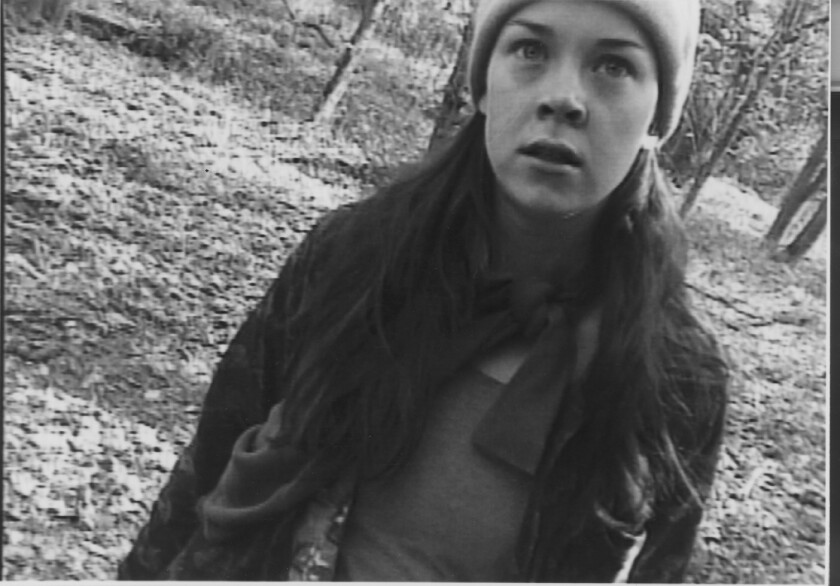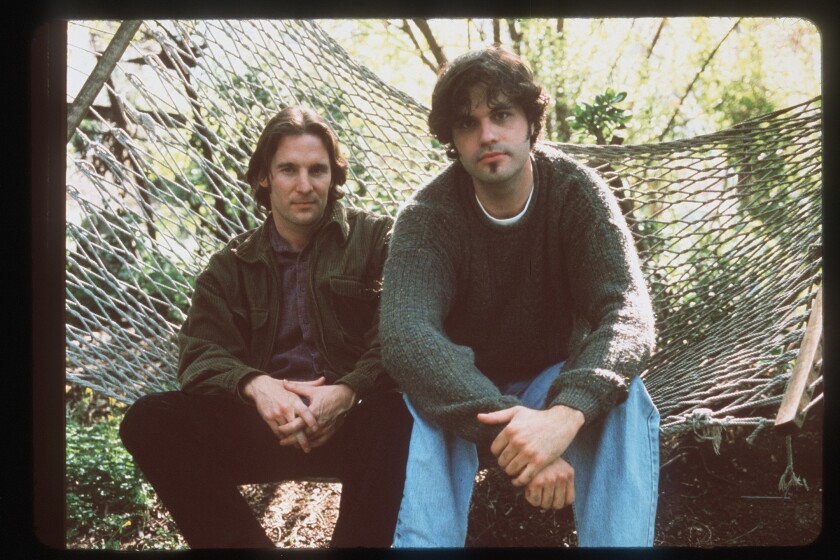Column: From ‘Blair Witch Project’ to ‘Yellowjackets,’ Eduardo Sánchez is still happily lost in creepy woods
Any “Blair Witch Project” obsessives who started combing the “Yellowjacket’s” finale frame by frame the moment they heard it was directed by Eduardo Sánchez can stop now. The Showtime series may tick many of the boxes that made Sánchez and Daniel Myrick’s first film a cultural icon — one half of the series deals with freaked-out young people lost in very creepy woods dotted with disturbing iconography — but Sánchez did not slide a random stick man into any “Yellowjacket” scenes.
He was tempted, he says. He managed to slide a “Blair Witch” symbol into the last episode of “Supernatural” he directed. Which, as the forest gods would have it, was filmed in the same Vancouver, Canada, location where much of the wilderness portion of “Yellowjackets” was filmed. Until recently, the paintball park that stands in for the forest home of the stranded girls’ soccer team was the woodland home of “Supernatural,” for which Sánchez directed five episodes, including one in the 15th and final season. In fact, when he described the cabin in which the Yellowjackets find shelter after their plane crashes to “Supernatural” production designer Jerry Wanek, Wanek said: “I built that cabin.”
No cinematic storyteller should turn down the combined juju of “Blair Witch” and “Supernatural,” but “Yellowjackets” is doing just fine with its own eerie and triggering symbol. Nor does Sanchez need to remind anyone of the enduring power of the Witch; she continues to manifest in everything from the little wooden figures in the first season of “True Detective” to the hot new Netflix series “Archive 81,” which opens with a young woman in obvious distress talking into a video camera and begging for help.

Dina Shihabi as Melody Pendras in “Archive 81.”
(Netflix/Netflix)
“Archive 81” is not entirely found-footage horror, the narrative form “The Blair Witch Project” turned into a subgenre. It chronicles the efforts of film archivist Dan Turner (Mamoudou Athie) to restore cassettes made by a doctoral student, presumed dead in the fire from which the cassettes were rescued. Like “Yellowjackets,” the new series toggles between two time frames, but the influence of “The Blair Witch Project” is strong enough that the film is name-checked at least once. And when Dan finds himself wandering through an empty wood, it’s hard not to scan the branches for hanging stick figures or the ground for eerie stone piles.
“I haven’t seen it yet,” Sánchez says in a recent conversation from his home in Frederick, Md. “I’ve heard it’s good and it’s definitely on my list. I still consider myself a horror filmmaker; I try to keep up with all the new work.”
When I tell him the “Blair Witch” name check comes in the form of a woman saying the tapes are fakes and “those ‘Blair Witch’ guys didn’t invent that,” he laughs.
“I was surprised that people are still doing found-footage,” he says. “And we didn’t invent it but it became a fad after our film. I’m a fan of a lot of these filmmakers and I love to see how found-footage has evolved. At first people dismissed it as amateurish filmmaking — you know, the shaky hand-held camera, the improvisation — but now they realize it’s not easy to do.”
In today’s world of the Marvel cinematic multiverse and of instant-peak TV, when shows flare up only to fade immediately under the next explosion, it’s hard to remember the seismic impact that the small but mighty “Blair Witch” had on horror, indie film and digital marketing. Many of those lucky enough to see it in theaters (including myself) often recount the experience in great emotional detail, as if they had survived the Titanic (the sinking ship, not the movie).
Not everyone loved the film or the out-there marketing meant to trick you into almost believing it was a documentary. But it was a nine days’ cover-of-Time wonder in a way few things are any more, and more than 20 years later it still follows Sánchez where ever he goes.
“A lot of people still want to talk about it,” he says, “and they wonder, ‘Does he want to talk about it?’ I’m happy to talk about it; it got me my career, it got me to ‘Yellowjackets,’ it got me to this interview. I love being one of the ‘Blair Witch’ guys.”

Heather Donahue is lost and weary in “The Blair Witch Project”
(Haxan Films)
Sánchez has directed several horror films, including “Curse of the Blair Witch” and “Lovely Molly,” but like many filmmakers he has increasingly worked in television. In 2014, after Sánchez helmed episodes of the short-lived series “Intruders,” Robert Rodriguez drafted him to direct on “From Dusk Till Dawn: The Series” for the then-new El Rey network.
“He’s a legend, so how could I say no?” says Sánchez, who was born in Cuba. “He said we’re going to do a bunch of shows with Hispanic directors, which was such a great idea. And I learned so much every day on the set, how to be a boss, how to make TV.”
He had a couple of other series set up for El Rey that never made it out of development, and the network went dark in 2020 before announcing a new streaming deal with Cinedigm last year. “Robert definitely put the spotlight on Hispanic issues and introduced a lot of Hispanic actors to other audiences. There’s a lot of Latino shows that seem to be in development, but it’s hard to get a green light.”

Eduardo Sánchez at the 20th anniversary special screening of the “The Blair Witch Project” during the 2019 Sundance Film Festival.
(Michael Loccisano/Getty Images)
Since then, he has directed for a variety of series, including “Lucifer,” “Queen of the South” and “American Horror Stories,” and although he has a feature film in development, Sánchez is, like many, increasingly happy to be working in television. But his first love is horror, and even with all the new special effects and streaming’s binge model, serialized horror is hard to do.
“You have to create a situation in which the main characters don’t or can’t run away,” he says. “I mean at a certain point, the audience will wonder, ‘Why don’t they just leave the house or kill that guy?’ So you have to figure out how to keep them in whatever horror bubble you’ve created. That’s why ‘American Horror Story’ works so well as an anthology. The art of horror is keeping stuff from the audience; once you reveal something, you have to write for it and then it’s less scary.”
That is something the creators of “Yellowjackets” understand; brief glimpses of what appears to be a cannibalistic rite remain just that throughout the show’s first season — brief glimpses. Both the teenage characters and their adult versions endure more than enough drama and trauma to keep audiences enthralled as the big question remains unanswered (and not really even addressed) in the season finale.
Sánchez was thrilled when he was offered the finale — and a little intimidated. First of all, he’d be walking into the story at its climax, and then there was the bear. And the snow.
In one scene, a bear comes out of the woods and threatens the young women before it is subdued and killed in a dramatic and mystical way. Reading this scene on the page made Sánchez very, very anxious. “There was a very famous bear in Vancouver who did all sorts of movies; he was like a rock star bear. I said ‘Let’s get him.’ But he had passed away. So we got this other bear and the first thing the trainer says is, ‘Well, we don’t always know what he’s going to do.’ So interacting with the actors was out, and even the camera crew were behind this electric fence.”

Ella Purnell as Teen Jackie in the finale of “Yellowjackets.”
(Kailey Schwerman/SHOWTIME)
Fortunately, the bear put in an excellent performance, Sánchez says, and they were able to green screen him in with the actors.
The snow, on the other hand, had to be trucked in and trucked out, which was a lot. “TV is challenging in its own way, and this is ambitious TV. You have to deal with a lot of logistical issues, look for reductions where you can but still give the writers what they are asking for.”
If nothing else, “Blair Witch” taught him how to be logistically creative. He and Myrick did not have to deal with a bear, but neither did they have access to a sprawling paintball park. Much of the film was shot at Seneca Creek State Park near Gaithersburg, Md., and spinning a tale of three people lost in what was actually a two-square-mile state park requires some serious fake-outs. “There were times when if you moved the camera a bit, you’d see the road, or a parking lot. We had to zigzag the cast a lot.”
What wasn’t faked, Sánchez says, was the spookiness of the ruined house in which the film ends. The ruins of Griggs House, in nearby Patapsco Valley State Park, quickly became a top fan destination. When they were demolished a few year ago following a storm, many fans protested, but Sánchez admits he doesn’t feel terrible about it.
“I always felt like something bad happened in that house. I remember one night after we were shooting I looked up and realized everyone else had left and I just freaked out, ran out of there like a fool. It was a genuinely scary place.”
Along with revitalizing found-footage, “Blair Witch” is often credited with revolutionizing the digital ad campaign, of not just building a fan base but activating the kind of passionate online engagement every film and series now courts.

Dan Myrick and Eduardo Sánchez, co-writers, co-directors and co-editors of “The Blair Witch Project,” in 1999.
(Artisan Entertainment)
More than 20 years later, that fan base is still endlessly searching for signs of life in the “Blair Witch” universe, which now includes “Yellowjackets.”
“There are a couple of ‘Blair Witch’ sites I look at and after the ‘Yellowjackets’ finale ran, they were all looking for stick men,” Sánchez says. “Especially in the scene where Jackie is building the fire. But there aren’t any.
“Sometimes,” he adds, “I think I need to move away from people being stuck in the woods. But I’m really hoping they ask me back to ‘Yellowjackets.’ I’ll definitely try to get a stick man in if they do.”
For all the latest Entertainment News Click Here
For the latest news and updates, follow us on Google News.
